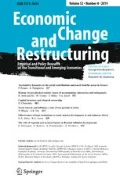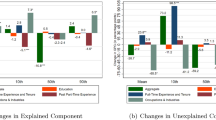Abstract
In this paper we examine the gender pay gap in Poland over 1987–1996, i.e., shortly before and during the transition to market economy. The principle source of data used throughout the paper is the Household Budget Survey conducted by the Polish Central Statistical Office. The study documents three major results. First, the transition to market economy in Poland favored women substantially in terms of relative earnings differentials. The gender pay gap decreased by 10.2 log% points and the position of mean female in male wage distribution went up by 9.9 percentiles over 1987–1996. By 1995, the values of these measures reached the level observed in industrial economies such as the U.K., Austria, Italy or Australia. Second, rising relative skills of women and rising returns to skills explain about half of the fall in the gender pay gap over 1987–1996. Third, the pay gap did not follow a smooth adjustment process. 1989, the year of the first democratic parliamentary elections, which resulted in forming the first non-communist government, saw the most spectacular change, although actual market reforms began one year after. The changes in the early phase of the transition were mostly driven by sudden shifts in relative wages and employment across industries. Afterwards, the pay gap measures stabilized, partly because rising overall wage inequalities offset the advantages of females due to observed skills.
Similar content being viewed by others
References
Adam, J. (1984), Employment andWage Policies in Poland, Czechoslovakia and Hungary since 1950, The Macmillan Press Ltd., London, Basingstoke.
Aigner, D.J. and Cain, G.G. (1977), Statistical theories of discrimination in labor markets, Industrial and Labor Relations Review 30(2), 175–187.
Becker, G.S. (1957), The Economics of Discrimination, Chicago, IL, University of Chicago Press.
Berg, A. and Blanchard, O.J. (1994), Stabilization and transition: Poland, 1990–91. In Blanchard, O. J., Froot, K. A., and Sachs, J. D., eds. The Transition in Eastern Europe, Chicago and London, The University of Chicago Press.
Bergman, B. (1974), Occupational segregation, wages and profits when employers discriminate by race or sex, Eastern Economic Journal 1(1–2), 103–110.
Blau, F. D. and Kahn, L. M. (1997), Swimming upstream: trends in the gender wage differential in the 1980's, Journal of Labor Economics 15(1), 1–42.
Blau, F. D. and Kahn, L. M. (2000), Gender differences in pay, Journal of Economic Perspectives 14(4), 75–99.
Brainerd, E. (2000), Women in transition: changes in gender wage differentials in eastern Europe and the former Soviet Union', Industrial and Labor Relations Review 54(1), 138–162.
Concise Statistical Yearbook of Poland, various issues, Warsaw, Central Statistical Office.
Hunt, J. (2002), The transition in East Germany: when is a ten point-fall in the gender gap bad news?, Journal of Labor Economics 20(1), 148–169.
Juhn, Ch., Murphy, K. and Pierce, B. (1991), Accounting for the slowdown in black-white wage convergence. In Kosters, M., ed., Workers and Their Wages, AEI Press, Washington, DC.
Keane, M.P. and Prasad E. S. (2002), Changes in the structure of earnings during the polish transition, IMF Working Paper, WP/02/135.
Levy, F. and Murnane, R. J. (1992), U.S. earnings levels and earnings inequality: a review of recent trends and proposed explanations, Journal of Economic Literature 30(3), 1333–1381.
Oaxaca, R. (1973),Male–female differentials in urban labor markets, International Economic Review 14(3), 693–709.
Ogloblin, C. G. (1999), The gender earnings differential in the Russian transition Economy, Industrial and Labor Relations Review 52(4), 602–627.
Orazem, P. F. and Vodopivec, M. (2000), Male–female differences in labor market outcomes during the early transition tomarket: the cases of Estonia and Slovenia, Journal of Population Economics 13(2), 283–303.
Romer, M. T. (1993), Labour Law in Practice, Warsaw, Neumann International Management Consultants and Twigger SA.
Rutkowski, J. (1994), Labor market transition and changes in the wage structure: the case of Poland', Discussion Paper No. 32, Polish Policy Research Group, Warsaw University.
Rutkowski, J. (1996), High skills pay off: the changing wage structure during economic transition in Poland, Economics of Transition 4(1), 89–112.
Schultz, T. W. (1975), The value of ability to deal with disequilibria, Journal of Economic Literature 13(3), 827–846.
Socha, M. W. and Sztanderska, U. (1991), Labor market in the transition to the market economy in Poland', Discussion Papers, No. 2, Polish Policy Research Group, Warsaw University.
Wellisz, S., Iwanek, M. and Bednarski, M. (1991), Privatization of state enterprises, Discussion Paper No. 3, Polish Policy Research Group, Warsaw University.
Author information
Authors and Affiliations
Rights and permissions
About this article
Cite this article
Grajek, M. Gender Pay Gap in Poland. Economics of Planning 36, 23–44 (2003). https://doi.org/10.1023/B:ECOP.0000005729.71467.38
Issue Date:
DOI: https://doi.org/10.1023/B:ECOP.0000005729.71467.38




